You will need: a "14" wrench, special pullers for removing the compressor pulley and bearing retaining ring, a press or a tool for pressing out bearings.
1. Remove the refrigerant from the air conditioning system (see Removing Refrigerant from the Air Conditioning System) and disconnect the wire from the negative terminal of the battery.
2. Remove the compressor (see Compressor Removal and Installation).

3. While holding the pressure plate from turning, unscrew the fastening nut..
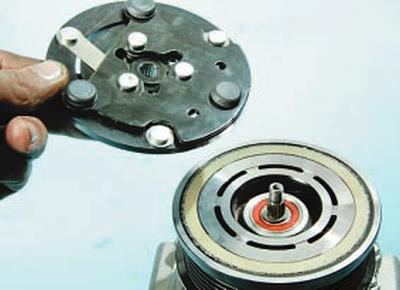
4….and remove the plate from the compressor shaft.

GOOD ADVICE: To keep the compressor pressure plate from turning, use a special tool.
NOTE: If the pressure plate has rusted to the shaft spline during use, do not attempt to remove it by inserting a screwdriver into the gap between the pulley and the plate. This will lead to deformation of the plate and the need to replace it.

To remove the pressure plate, use a special puller.
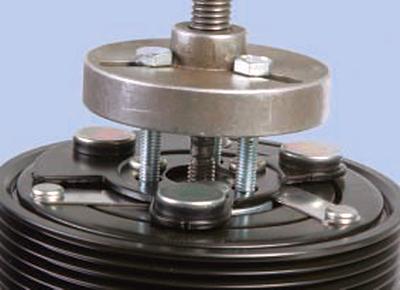
Screw the bolts of the puller into the threaded holes of the pressure plate and, turning the stop screw of the puller, compress the plate.

Sometimes the threads in the holes may be missing. In this case, cut the M5 or M6 threads in the holes yourself.
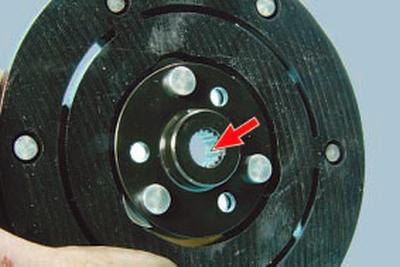
5. Inspect the pressure plate slots.
If the splines are worn, replace the plate.

6. Inspect the surface of the shaft seal.
If there are signs of oil leakage through the shaft seal, the compressor must be replaced.
USEFUL ADVICE: In some cases, if a leak is detected, the gland can be replaced. However, it should be remembered that a leak, as a rule, is caused by shaft play due to wear of the thrust bearings, corrosion or wear of the shaft surface in the area of \u200b\u200bthe seal. Therefore, the replacement of the gland will give at best only a short-term result.
If a gland leak is detected, it is recommended to replace the compressor assembly.

7. Squeeze with a special puller..

8….and remove the pulley bearing circlip.

NOTE: Use a special expanding tool to remove the retaining ring.
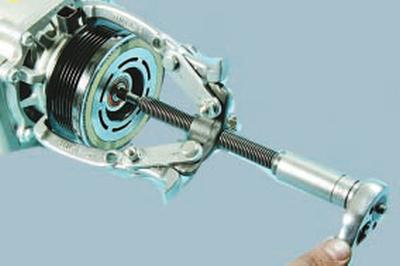
9. Install the three-arm puller..

10.... and press the pulley from the landing neck of the front cover of the compressor.
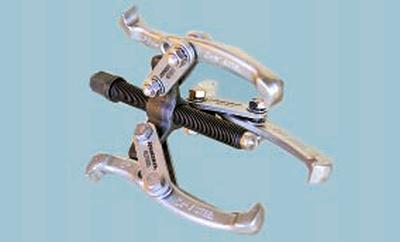
USEFUL ADVICE: It is convenient to use a universal three-arm puller to remove the pulley.

11. Inspect the working friction surfaces of the pulley and pressure plate, paying attention to the presence of deep scratches, scoring, obvious signs of wear and overheating. Replace defective parts if necessary.

NOTE: Inspect rivet connections A and B and elastic steel drivers C of the plate. If the drivers are broken or the rivets are loose, replace the pressure plate.

12. After removing the pulley, inspect the splines 3 and the threaded tip 2 of the shaft, the groove 4 for the retaining ring and the seating surface 1 of the neck of the cover (for clarity, the magnet coil is removed). If they are worn or damaged, the compressor must be replaced.

13. On a lathe, cut off the folds that secure the bearing in the pulley.

14. With a mandrel of a suitable diameter, press the old bearing out of the pulley.
WARNING: Once removed, the bearing is not reusable and must be replaced.

15. Press in the new bearing. When pressing in, apply force only to the outer race of the bearing. As a mandrel, you can use the clip from the old bearing.

16. After pressing, fix the bearing by punching the edge of the pulley mounting hole.
WARNING: Be very careful when pressing the bearing.

The outer race of the pulley bearing has a very thin wall. Even slight misalignment can lead to bearing failure. After pressing, check the condition of the bearing. It should rotate evenly, silently, without jamming. There must be no axial and radial play.

17. Press the pulley onto the compressor front cover. When pressing on, apply pressure only to the inner race of the bearing.

18. Install retaining ring.
WARNING: After installing the pulley on the compressor, make sure that the pulley rotates evenly, silently, without binding. There should be no axial or radial runout. Otherwise, the pulley must be replaced.
19. Put the pressure plate on the shaft and screw on the fixing nut. Tighten the nut to 13 Nm.
20. Install the compressor in a vise.
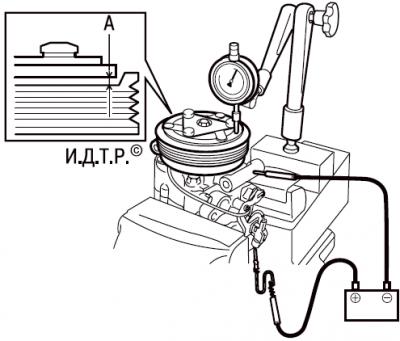
21. Install the dial gauge as shown. Connect the positive battery terminal to the coil winding connector and the negative battery terminal to the compressor housing. Measure the gap A between the friction surfaces of the pressure plate and the pulley (the gap value is equal to the measured difference between the on and off clutch of the air conditioning compressor) every 60°around the circumference. If the gap is not the same at different points on the circle, then the pressure plate is deformed and must be replaced. The nominal gap is 0.35–0.85 mm.

22. If the gap differs from the nominal, remove the pressure plate. Using shims mounted on the rotor shaft, adjust the gap. Put on the pressure plate again and check the resulting gap.

NOTE: Use special calibrated shims to adjust clearance.
23. Install the compressor and all removed parts in the reverse order of removal.
24. Charge the A/C system with refrigerant at a qualified automotive A/C service center.
Visitor comments